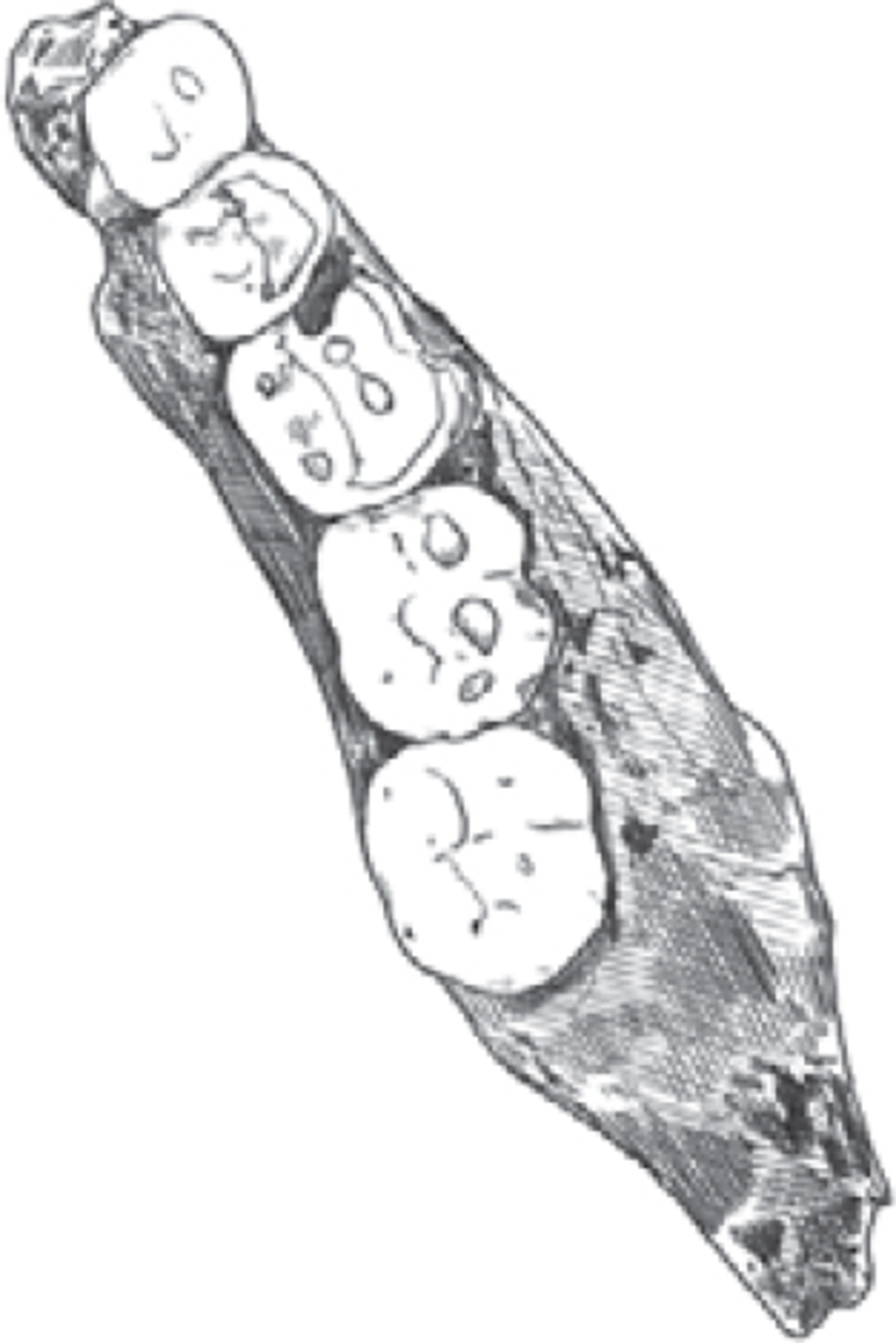21
The bones that littered the floor were coated in brown clay that stuck to their surfaces. Here and there, white flecks shone on the cave floor, indicating that some of these bones had been broken, not long ago. This damage, almost certainly from some caver who apparently did not notice the significance of what he passed, had prompted the urgency of this expedition. Large blocks of dolomite bedrock thrust up out of the clay, some with bones atop them. I knew they were the ones Steven and Rick had placed there to photograph on that second visit.
I waited long enough for Marina and Becca to enter the end of the Chamber and then tested the intercom system, using the third phone set up solely for this purpose. My voice should come over the speaker Rick and Steven had set up earlier in the Chamber. We had no visuals yet: Marina and Becca still had to connect the two final cameras.
“How’s it looking down there?” I asked. I could hear the echo of my voice in the Chamber.
“It’s all good!” replied Becca.
“All good,” agreed Marina, although I could tell that they were preoccupied with the setup and the tension of having just arrived.
Soon one of the blank blue screens, the one labeled “Camera 6,” flickered to life, resolving a hazy image into the face of Marina, peering into the lens. I picked up the phone.
“We’ve got you on Camera 6,” I said.
“OK!” She smiled into the lens.
Becca and Marina began to unpack and set up the other equipment. Their mission was to scan the cave and recover the mandible as the first find. We watched them set up the laptop computer and connect the Artec scanner. As they activated it, a fluorescent tube cast a bright white light, and the scanner began capturing data, rhythmically flashing as it started in on the essential work of mapping all the specimens. If the scanner failed, we would have to stop the entire excavation until we figured out another mapping solution. The flickering image of the cameras made many of us feel as if we were witnessing a space walk. We watched in tense silence from the surface above them, unable to participate or help.

EVERY ARCHAEOLOGICAL DISCOVERY IS an act of destruction. The debris of thousands of years sits locked within sediments, the position of every artifact and bone holding clues about how they are related to each other and to the creatures who may have left them there. Digging into such a site necessarily destroys this arrangement, and if archaeologists do not record exact details before excavating, critical information will be lost forever. This is one reason it is responsible to leave some parts of archaeological sites in place without digging them, in case some future technology will be able to recover information that we cannot obtain today.
At a site in the open air, or even in many caves, researchers can stretch a large grid of string across the entire area, measuring distances in vertical depth from the gridlines, pinpointing the three-dimensional locations of objects that way. Because the area we were exploring was such a small space, a grid like that was impossible: It would completely impede movement and create risks for the artifacts and the explorers. It was a problem we hoped the scanner would solve. By scanning the entire surface of the Chamber into the computer, we could record the three-dimensional position of everything. Following excavation protocol, the team was to catalog bone fragments and samples, scan the entire surface, and only then lift the artifacts. This technique allowed us to virtually re-create the entire three-dimensional configuration of the site as if we had virtual x-ray vision and could take the site apart bone by bone and put it back together again.
The first scan took a long time. Eventually, though, the whole area around the mandible was scanned. I breathed a sigh of relief: The system was working so far. We all watched as Marina cataloged the area and prepared the label that would accompany it from here forward. Becca started up the scanner again, slowly sweeping it across the cave surface as if she were spray-painting it. As she did so, a virtual model of the surface appeared on the laptop screen, now without the mandible in place—a virtual before-and-after picture in three dimensions had thus been captured.
Then something started beeping: the carbon dioxide detector. Carbon dioxide buildup is one of the very real dangers of working in limestone cave systems. Heavier than air and odorless, it can build up to dangerous levels in confined spaces with poor airflow. It can also build up as a simple factor of exhalation in relatively sealed chambers. At low levels it’s harmless, but once it rises above one percent in the atmosphere—a situation cavers call “foul air”—it can be incredibly dangerous. The effects are first rapid breathing and increased heart rate, but carbon dioxide poisoning can quickly lead to loss of consciousness and even death.
Marina called up on the telephone. “Command Center, we have a carbon dioxide alarm.”
“OK, copy that. Let’s get you guys up now.” We had rehearsed for just such an event, and Marina, Becca, and Steven calmly closed down the work they were doing and ascended, retracing their route back out of the cave with no incidents. As we all looked on anxiously from the surface, their images appeared on each of the cameras in reverse order, every few minutes reaching a new checkpoint until they were at the Ladder. Then, five minutes later, they emerged from the cave.
They had been underground an hour and a half in total. Despite the scare of the carbon dioxide alarm, both Marina and Becca were beaming as they came out of the cave, dirt smudged onto almost every surface of their blue jumpsuits and faces. We all applauded, and I couldn’t help giving each a hug, relieved they were out safely. I was surprised to see that Becca had along with her the gray watertight bag meant for bringing fossils up from the Chamber. She handed it to me with a smile.
“You collected the mandible?” I asked.
“Of course,” she responded.
I was thrilled.
Carrying the bag down the hill to the Science Tent, I felt like the Pied Piper of Hamelin, with a trail of cavers, scientists, and students following me. I handed it over to Steve Churchill, with Peter Schmid hovering next to him, and watched as Steve carefully unwound the bubble wrap and exposed the jawbone. People crowded around. I looked over Steve’s shoulder at one of the most wonderful sights I had ever seen: the right half of a fossil hominin mandible.
It was broken at the front, just at the level of the fourth premolar, and the joint that attaches the jaw to the skull was broken off the back of it. A hard coating of brown clay clung to one side, but otherwise the jaw was pristine, the enamel of its teeth shiny and bright. First Steve, then Peter examined it for a few moments. Then I handled the specimen myself.
I lifted the small jaw for the first time. I was surprised at how light it was. In many of the fossils from other sites of the Cradle, the original substance of the bone has been replaced almost entirely by hard calcite, making them dense and heavy. Many of the sediba fossils, for example, have been partially transformed to stone in this way. But some fossils remain light, having lost some of their mineral content. This fossil jaw was very light: It felt fragile.


The first jawbone recovered from Rising Star
I examined the specimen, turning it over in my palm. I was shocked. It was smaller than any of us had expected from the photos. The proportions were what the photos had led us to expect: The third molars were the largest teeth, as in australopiths and different from humans. But the teeth were tiny, really no larger than those of a modern human. I had never seen teeth so small in any extinct hominin. I passed the mandible to John Hawks to have a look and leaned back, not really listening to all the excited voices around me, just thinking: What was this creature?

MEANWHILE, THE HARD DRIVE with the scan data had gone up to the Command Center, where Ashley Kruger had gone to work. Ashley was responsible for managing the data generated by the underground scanner. As he loaded up the data from the hard drive, a ghostly pink landscape appeared on the computer, the three-dimensional surface model of the floor of the Chamber. The crowd moved back to the Command Center to watch this activity. It was, I thought to myself, like watching a crowd at a golf tournament moving from one hole to another, unsure of which famous pro to follow. Everything was interesting now that the science of the expedition had begun. The images coming from the scanner were stunning as Ashley worked on them. Later, he would overlay the data with the color images from the scanner to create a virtual model of the surface just as the excavation team had seen it.
As it turned out, the carbon dioxide scare had been a false alarm. The detector had been mistakenly set to sound the alarm at the slightest elevation in CO2. That was a big relief. After recalibrating, we never heard a further peep from it. As deep as the Chamber was underground, enough air flowed through the cracks and narrow passageways to keep the CO2 levels safe.
As sunset approached, the video feed caught a handful of bats winging up past the Ladder. The team was outside, posing for pictures, and then time for supper. We turned off the generator and called it a night.